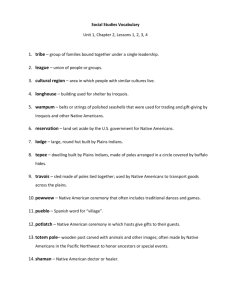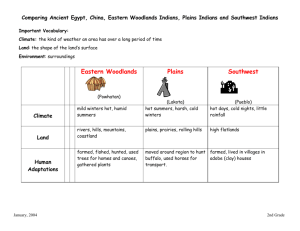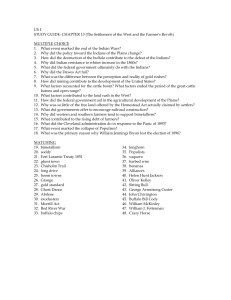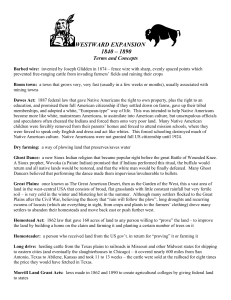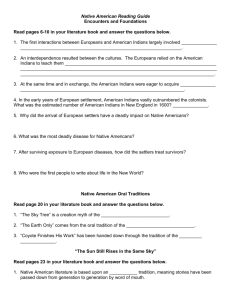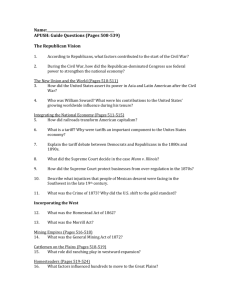Chapter 17 - Pine Tree ISD
advertisement
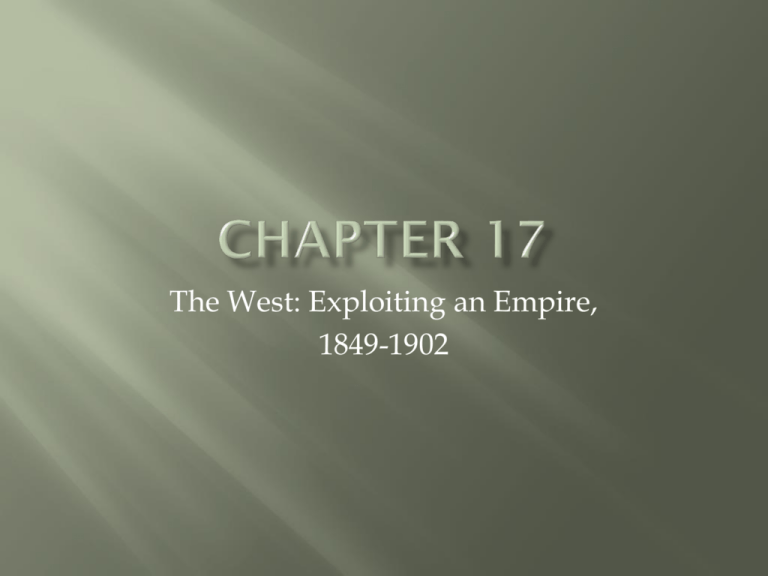
The West: Exploiting an Empire, 1849-1902 Cheyenne Chief, Lean Bear visited New York & Washington DC in 1863. He met w/ President Lincoln. Lincoln assured him that the government wanted a peaceful and orderly migration into the West, but warned that many of the pioneers could not be restrained. A year later, US soldiers killed Lean Bear in cold blood. “The Great American Desert”, was long thought to be uninhabitable by anyone but aborigines. By 1840 white settlement had paused at the edge of timber country in Missouri. Beyond that was the Great Plains. There was rich soil & good rainfall in the Easter Plains, but the rough High Plains were semiarid. The Rockies & other mountain ranges held back rainfall, barely 15 in. a year. Traditional farming was ineffective so early settlers headed directly to the temperate Pacific Coast. AS folks began moving west of the Mississippi, they encountered new conditions including vast treeless plains and towering mountain ranges. Most of all they left behind water and timber and had to devise ways of dealing w/ new challenges. By 1867, nearly 25 million Indians inhabited the western half of the US. The tribes originally from the East kept moving west b/c of the waves of settlers. Others were native to the region, w/ cultures suited to their environments. Within 12 yrs those many white settler confrontations forced the Indians onto small reservations, and diseases introduced by whites had decimated the California Indians. By the end of the 1890s, the Indian cultures had crumbled. So within that 30 yr span the Indians and they’re culture had been crushed. The Indians had developed a complex culture. The US government & white settlers employed methods – political, military, legal/illegal and cultural – to oust the tribes from their lands, ‘civilize’ them, and contain and control them. The horse aided the Plains Indians in the abandonment of farming to a nomadic lifestyle following the buffalo. When gold was discovered in California, the Great Plains became a highway to the Pacific & the government began to confine the Indians to specific areas causing wars & massacres. The Sioux War (1865-1867), Congress adopted a ‘small reservation’ approach, designed to keep the Indians out of the white mans way. The final series of wars began with the short lived Sioux victory @ Little Bighorn in 1876. Others took place as well; Wounded Knee (1890), when the army became determined to stop the ‘Ghost Dances.’ The final step was the ‘assimilation’ plan to use education, land policy and federal law to eradicate tribal authority and culture. Congress pass the Dawes Severalty Act (1887) which destroyed communal ownership of land and gave small farms to each head of a family. Those Indians who left the tribe became US citizens. The final blow to tribal life came when the buffalo were exterminated by professional & amateur white hunters. Only 250,000 Indians still inhabited the United States by 1900, and most lived in poverty. From 1870-1900 the rush for land settlement was intense, and so was the demand for livestock, agricultural, mineral, & lumber products. In 1849 with the California Gold Rush, settlers left St. Louis in April in order to get through the Rocky Mts. Before snow closed the passes. The 6 month trip was arduous. The Homestead Act (1862) distributed 48 million acres of western land. A settler would receive 160 acres for $10 and the promise to stay and work the land for 5 years. For the next 40 years the federal government ‘distributed’ ½ billion acres; mostly to states, private corporations, and individuals. 128 million acres were granted to railroad companies. Timber Culture Act (1873) granted larger tracts to settlers if they agreed to plant trees. Desert Land Act (1877) granted larger pieces to settlers who would install irrigation systems, but this lead to fraudulent buyers & contractors. Newlands Act (1902) help transform the West with federal money for irrigation projects. Mining, cattle, and land led to boom or bust economic cycles. The California Gold Rush brought individual prospectors who used placer mining to remove the surface gold. Corporations brought in heavy machinery to remove the metal from the deep lodes. The Black Hills rush of North Dakota (1874-76) brought miners into the Sioux hunting grounds and destroyed it. With each new strike brought a town and problems including hostility & racism. The Foreign Miners Tax in California drove foreigners out. Chinese Exclusion Act suspended Chinese immigration for 10 years. Mining led to early statehood for Nevada, Idaho, & Montana. Cattle ranching became prosperous on the plains. Cattle grazed on the prairies and were driven by cowboys to the railheads and then shipped to Chicago for slaughter. Farmers started fencing their lands and by 1900 30% of the country’s population lived in the Far West. Joseph Glidden expedited fencing with the invention of barbed wire. The migration of African Americans from the south helped fuel the transformation of the Plains. Exodusters moved to Kansas or Oklahoma. Settlers became disenchanted with the harsh conditions and other problems abandoned their homesteads and moved home or further west. They complained about declining crop prices, rising rail rates, & heavy mortgages. The Grange became a lobbying group for the plains farmer in the state & federal governments. In 1889, Indian Territory that had been reserved for the Indians was opened for white settlement. At noon April 22, thousands rushed in to grab land. By November 1907, Oklahoma was established as a state.

